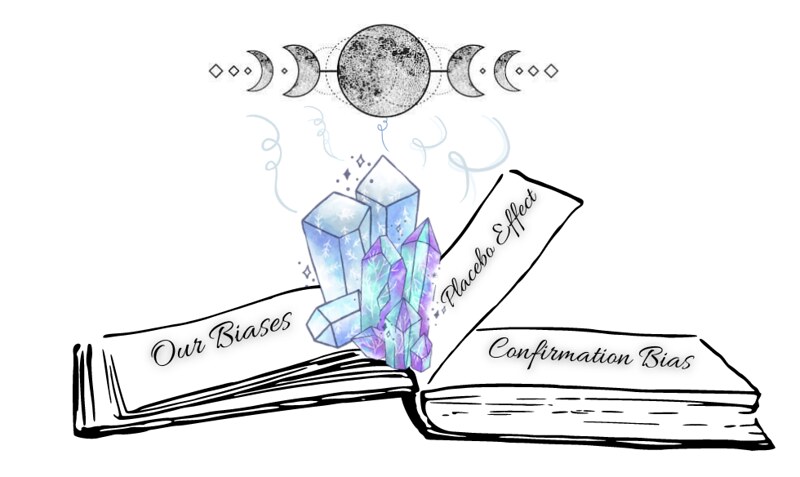Rose quartz. Hematite. Carnelian. If these names are meaningless to you, chances are that you’re not on TikTok.
The #Crystals hashtag has over 6.6 billion views on TikTok (as of Nov. 20, 2021) and rose quartz, hematite and moldavite are only three of dozens of rocks part of the crystal craze. In recent years, crystals have become increasingly popular amongst young adults for their alleged spiritual healing properties that allow “positive, healing energy to flow into the body as negative, disease-causing energy flows out,” as Elizabeth Palermo explained in a Live Science article. And it’s not just the ones on TikTok.
According to the Pew Research Center, 42% of Americans believe that spiritual energy can be harnessed from physical objects such as crystals. A collective distaste for materialism, a need for a psychological escape from the “times” (characterized by high rates of anxiety, political divide, etc.) and a general belief that spirituality is “an element of what it means to be human” are lifestyle writer Rachel Siemen’s hypotheses as to why the crystal (and spirituality) movement is growing so rapidly.
We each own three of the aforementioned crystals: rose quartz, carnelian and hematite. Rose quartz supports emotional and romantic well-being, carnelian to attract confidence and positive attention and hematite to ground the soul against stress and negative energy.
We’ve owned our crystals for over a year, yet both of us are still emotionally unstable, insecure and stressed. So do we still believe in the healing potential of crystals? Well, yes, but not necessarily for the reasons you would expect.
First, let’s establish that there is no scientific evidence that proves crystals have legitimate healing potential.
Sivana Spirit, a California-based spirituality and jewelry business, sells healing energy crystals. On their website, there is a page titled “The Scientific View On Crystal Healing: A Guide To Find Your Stone.” However, even within the guide, the company admits: “Science can’t necessarily measure the effectiveness of something that claims to work on an energetic healing pathway. As of right now, [crystal] effectiveness is purely subjective.”
Rather, the “spiritual” impacts we associate with using crystals are more a product of our minds and attitudes rather than the attributes of crystals themselves. In other words, crystals work because of psychology.
The crystal craze is a textbook example of the placebo effect, a psychological phenomenon that occurs when benefits from a specific practice are due to the subject’s beliefs and expectations rather than the practice itself. In this case, crystals are the placebo “drug,” and we, consumers, are the subjects that are affected by it. The benefits we see in our mental and physical health are because of our preset mindset that crystals are supposed to produce these benefits even when they don’t; any positive changes we do notice are immediately tied to the presence of crystals. It’s similar to unknowingly taking a sugar pill in a clinical trial; subjects would report benefits that would likely be exaggerated because of their preconceived mindset that the “medicine” they are taking is supposed to work.
The crystal craze is a textbook example of the placebo effect
In a study by Christopher French, the head of the anomalistic psychology research unit at the University of London, 80 participants participated in a meditative, crystal-healing session in which half held a real quartz crystal and the other a fake crystal that they were informed was real. However, before meditating, half the group were made aware of “potential” warming and tingling effects they could feel with their crystal.
After the session, “many participants in both groups reported feeling a warm sensation in the hand holding the crystal or fake crystal, as well as an increased feeling of overall well-being. Those who had been primed to feel these effects reported stronger effects than those who had not been primed. However, the strength of these effects did not correlate with whether the person in question was holding a real crystal or a fake one,” Elizabeth Palermo of Live Science reports.
“[You may think] ‘this crystal calms [me],’ but it’s no more than just you calming yourself down and just attributing it to the crystal,” Thomas Chamberlain, DVHS AP Psychology teacher, said.
Other similar psychological phenomena, confirmation and hindsight bias, also explain our blind fanaticism with crystals. Confirmation bias is defined simply as “the tendency of people to favor information that confirms our existing beliefs and hypotheses.” For example, both of us participate in competitive debate. When building our arguments, we often scroll through numerous sources that may express different opinions until we find the one, perfect piece of evidence to support the preconceived argument we’re building in our heads. Hindsight bias goes hand in hand; it is our tendency to feel certain about a specific cause of an event, usually one that supports our confirmation bias, but only after the event has occurred.
You can call it a bit of a gut feeling or justification; for example, sometimes after a debate round, we’ll insist to our partners that we “knew” we would win. Similarly, if a crystal enthusiast falls ill and recovers quickly in proximity to a crystal meant to positively affect their health during that time period, they may attribute the crystal as responsible for faster healing; we can’t say we haven’t thought about attributing at least some part of our recoveries to crystals when we’ve gotten colds in the past.
“You could’ve healed faster because it was a disease that didn’t last very long or you got a lot of rest; there could have been 1000 reasons why you got better quicker this time, but you’re using hindsight bias to attribute to the one thing holding your belief system,” Chamberlain said.
The psychology behind healing crystals should be defeating for crystal-enthusiasts like us to learn about. However, being aware of the psychological potential of crystals is empowering. Even if we educate ourselves about the placebo effect and different types of bias, we’re not above any of it. We can’t change the way we think; we unconsciously subject ourselves to each of the aforementioned psychological phenomena whenever we are actively aware of our crystals’ presence.
And that’s comforting for us. The psychological power of crystals serves as a form of security. In their proximity, we give ourselves an opportunity to build confidence in pursuing bold endeavors (such as deciding to apply to a college we didn’t think was worth trying before). In their absence, we have a reason to assure ourselves that bad days and embarrassing moments are not our faults. We know we’re playing mind games with ourselves. But if it’s our own consciousness playing tricks on us and we’re aware of it, can we really say we’re being fooled by crystals?
What others dismiss as mind games is not necessarily harmful; believing in our crystals allows us to access our inner potential, counter fears and inspire confidence in ourselves even when we are simply two overthinking, pessimistic teenagers.
This story was originally published on Wildcat Tribune on February 7, 2022.































![IN THE SPOTLIGHT: Junior Zalie Mann performs “I Love to Cry at Weddings,” an ensemble piece from the fall musical Sweet Charity, to prospective students during the Fine Arts Showcase on Wednesday, Nov. 8. The showcase is a compilation of performances and demonstrations from each fine arts strand offered at McCallum. This show is put on so that prospective students can see if they are interested in joining an academy or major.
Sweet Charity originally ran the weekends of Sept. 28 and Oct. 8, but made a comeback for the Fine Arts Showcase.
“[Being at the front in the spotlight] is my favorite part of the whole dance, so I was super happy to be on stage performing and smiling at the audience,” Mann said.
Mann performed in both the musical theatre performance and dance excerpt “Ethereal,” a contemporary piece choreographed by the new dance director Terrance Carson, in the showcase. With also being a dance ambassador, Mann got to talk about what MAC dance is, her experience and answer any questions the aspiring arts majors and their parents may have.
Caption by Maya Tackett.](https://bestofsno.com/wp-content/uploads/2024/02/53321803427_47cd17fe70_o-1-1200x800.jpg)
![SPREADING THE JOY: Sophomore Chim Becker poses with sophomores Cozbi Sims and Lou Davidson while manning a table at the Hispanic Heritage treat day during lunch of Sept 28. Becker is a part of the students of color alliance, who put together the activity to raise money for their club.
“It [the stand] was really fun because McCallum has a lot of latino kids,” Becker said. “And I think it was nice that I could share the stuff that I usually just have at home with people who have never tried it before.”
Becker recognizes the importance of celebrating Hispanic heritage at Mac.
“I think its important to celebrate,” Becker said. “Because our culture is awesome and super cool, and everybody should be able to learn about other cultures of the world.”
Caption by JoJo Barnard.](https://bestofsno.com/wp-content/uploads/2024/01/53221601352_4127a81c41_o-1200x675.jpg)






